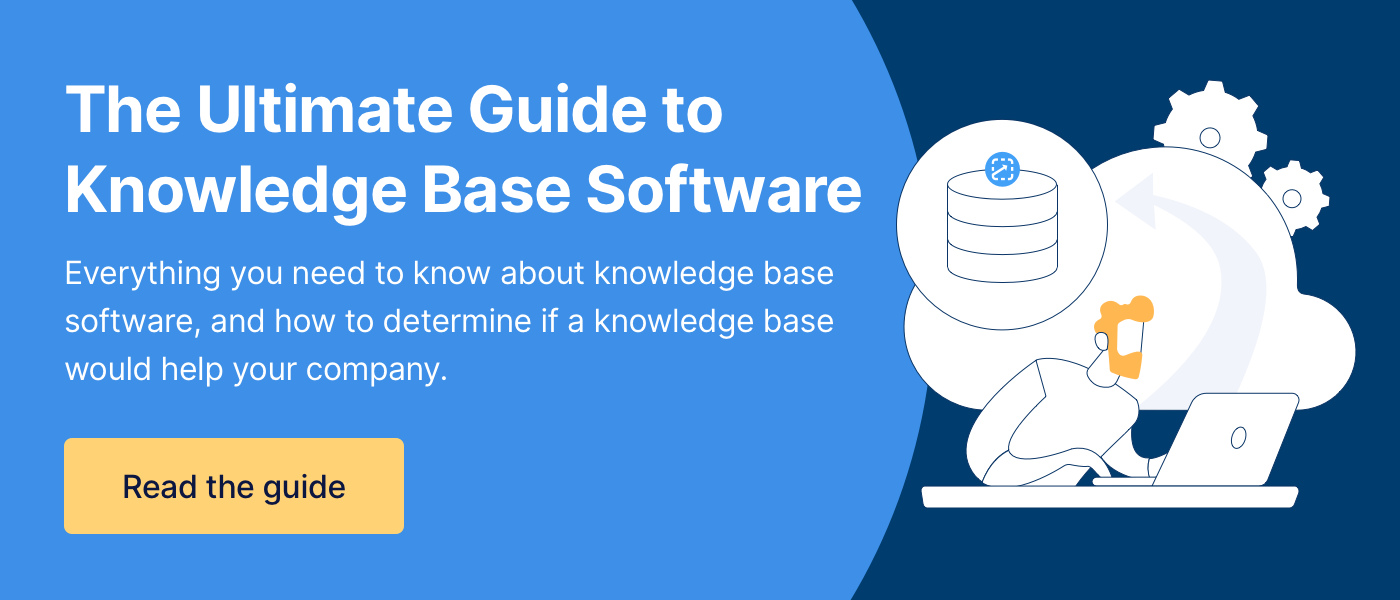Pros and Cons of Using a Learning Management System for Employee Training
Raise your hand if you’ve ever tapped through a self-paced training course without really paying attention.
* Raises hand *
Yep, I’m guilty as charged. Though I should clarify that it was a compliance course I’d taken before and I got enough information to pass the quiz. And I know I’m not alone.
On the other hand, I’ve also taken self-paced courses that are interesting and informative. I’ve learned a lot. Or, at least, it provided me with enough information that I felt more prepared to learn more about the topic in another setting.
These courses were taken with a learning management system (LMS). And, like most of you, I’ve had positive and negative experiences with taking LMS courses.
So, is it worth it to use an LMS for your employee training?
That’s up to you. Working for ScreenSteps — a knowledge base software and training solution — I’ve learned a lot about training strategies and options on the market. An LMS can be a powerful tool … if you use it correctly (but we’ll save that discussion for another day).
Today, I’m sharing pros and cons of using an LMS in your employee training. Hopefully, these advantages and disadvantages will help you narrow down whether an LMS can support your team.
Pros of using an LMS for training
An LMS can be a powerful training tool if you create the right courses. Here are a few of the advantages when you train with an LMS.
1. Gives an official feel to you courses
While this might seem trivial, don’t underestimate creating a training curriculum that has an official feel to it.
It gives you and your employees confidence it what you are doing. It provides organization and a clear path forward for what a portion of your training will look like.
2. Provides off-the-shelf courses
Many LMS software applications offer off-the-shelf courses. By “off-the-shelf,” I mean that the courses are prepared and packaged by a professional.
These courses come ready-made. All you have to do is assign your employees to take the courses.
Off-the-shelf LMS courses work for general business topics, like computer safety, compliance, etc. These are typically lessons that can be used in any business across the globe.
The downfall of off-the-shelf courses is they are not specific to your company and the standard operating procedures (SOPs) you have. This brings me to another advantage.
3. Allows you to create courses unique to your company
If you need courses specific to your company, you can create them in your LMS (depending on the type of LMS you get).
You will need to build out the courses. They could include videos, articles, quizzes, interactive activities, and whatever you need to create a complete course.
This allows you to personalize your lessons and teach your employees exactly what they need to know while working for your company.
4. Includes interactive learning options
LMS courses are self-paced courses, so it’s difficult to tell how engaged your learner is as they go through a course. One way LMS software services remedy that is by providing interactive activities.
The most obvious interactive option is a quiz. After each module of your course, you can have employees take a quiz to see what information they retained for the course. (Remember: This is short-term memory retention if they are taking the quiz while taking the course.)
Another interactive option is providing an image and asking employees to select the items that relate to a lesson.
For example, in a compliance course, you could have an image of a desk and ask employees how many compliance violations existed. Employees may spot a sticky note with a password right by the computer or other compliance grievances.
5. Provides options for learning
Most likely, an LMS will not be your only training option. It will be a piece of your training strategy.
Your training curriculum will include other training opportunities. That could include classroom or virtual training, discussions, role-playing, shadowing, etc.
Consider what role you want an LMS to take in your training. Is it to introduce employees to concepts? Is it to train them on annual compliance training? Is it to subsidize classroom training?
6. Uses awards and badges to motivate learners
One advantage of using an LMS for training is that it can make training a little more fun. There are features that help you gamify the training process.
Many LMS services provide opportunities for your employees to earn badges or some other form of recognition or award. These badges help motivate and encourage your employees to take and complete the assigned courses.
7. It provides continuous learning options
Sometimes we only think of training as onboarding. With an LMS, training can continue after onboarding is complete.
Employees can learn to develop additional skills that will help them advance in their careers. Your employees will always be learning on the job. An LMS makes that learning experience more tangible and achievable.
Cons of using an LMS for training
While an LMS can be an excellent tool for training employees, it does have some shortcomings — especially when companies rely heavily on their LMS courses. Here are some of the cons of using an LMS during training.
1. People forget the course
When people take courses on your LMS, they are self-paced. Typically, the courses include a lot of information. This approach requires your employees to remember everything they are told.
Unfortunately, the human mind isn’t perfect. Your employees with forget at least part of the information shared in the LMS course.
An LMS fixes more of the checklist for your company to say you shared information, whether that was for compliance or another reason. It doesn’t, however, provide employees with the knowledge and tools to do their jobs.
2. It’s a passive learning experience
By passive learning experience, I mean the learner is not engaged. Employees can sit back or do other tasks while the training runs on another screen.
But, what if there is a quiz?!
Even quizzes fit in with passive learning if the quizzes aren’t testing what was discussed in detail. Often, companies write LMS quizzes that have super obvious answers. Your employees don’t have to be engaged to get the answers right.
Plus, the things your employees are being tested on don’t translate to them being able to do their job. An LMS doesn’t provide on-the-job learning experiences.
3. It’s difficult to build a library of in-depth courses
Building out a training curriculum is no joke. And building an in-depth training course takes a lot of work. It’s difficult to build a library of in-depth courses for people.
What often happens is companies settle. They just need to get something up. So, often departments put training information in a PowerPoint presentation. They send it to HR and tell them to put it in a course.
If you are a small team, you don’t have time to create full courses.
4. It’s difficult to measure the effectiveness of an LMS
Your employees only take a course one time. How much did they retain? And how much was spouting off knowledge vs. seeing how they perform their jobs?
Unfortunately, teams often put in all this work to prepare training courses. Then people are still making mistakes in the end. LMS training provided all the information they were required to know, but it didn’t teach new hires how to do their jobs.
5. Metrics don’t directly correlate with job performance
With an LMS, you have metrics, like:
- Who completed courses
- How far employees got in a course
- How employees performed on their quizzes
- Which badges your employee has earned
These metrics don’t tell the story of how well trainees can do their jobs. While these metrics prove your employees have taken your courses, they don’t show how good your employees are at their jobs.
It doesn’t indicate how proficient they are at completing their assignments without making mistakes. The reports don’t provide insight into what further training actions need to be taken.
You want your training to tie to performance metrics, like sales or the number of mistakes.
6. Employees can’t use a course “in the moment” they need support
As mentioned above, your employees only watch or read your training course once. Then they are supposed to remember everything they learned and apply it to their jobs.
But the catch here is humans don’t have a perfect memory. Your employees often forget things and need a resource to reference.
If all your information is tied up in courses, your employees can’t access that information very easily. It is not easy for employees to go back and review a course in the moment you need the information.
If they have a customer-facing position, then they can’t pull up the lessons in the moment of need. Plus, it is hard to search your LMS for the specific answer they need.
7. Courses can’t (and shouldn’t) be detailed
Your LMS courses cover overarching ideas. They don’t get into the nitty-gritty details of how to do a procedure.
A course provides background information, but they can’t walk an employee through a procedure. That’s because that requires an employee to either memorize a significant amount of steps and decision trees and/or reference the training course.
8. It doesn’t have an option for storing training guides and job aids
When employees are on a job and forget something, they need to be able to reference the information they learned in training. Courses are not good reference materials.
What employees need is documented job aids and help guides. Employees can then find the appropriate guide and find the specific instructions they need without having to watch a 20-minute course to find one detail. Ideally, these guides would be interactive.
Sometimes LMS software remedies this by providing downloadable PDF files on the courses. Be cautious: It is easy for these PDF guides to become outdated or inaccurate.
It’s better to have a service that centralizes your knowledge into one accessible location, like a knowledge base, intranet, or document library.
Pair your LMS with other training software for a more impactful employee training strategy
With an LMS, you can build powerful courses that help prepare your employees for their jobs. If you want your LMS to be truly impactful you need to pair it with other training software and strategies.
One of the best software solutions to pair with an LMS is a knowledge base. A knowledge base fills the gap that an LMS misses — it provides resources for employees that they can reference on the job.
A ScreenSteps knowledge base makes it easy for you to create, store, and share documented help guides with your employees. It is a one-stop shop for all of your company’s information and knowledge.
They are fast and easy to access when they have questions. They can find the answers they need in as few as two clicks.
It even includes courses — though not with as many options as an LMS — to provide employees with background information and context.
Learn more about knowledge bases and how they can support your company. Read the ultimate knowledge base guide here.



